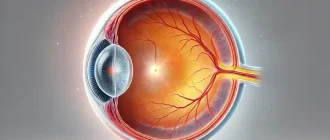Photobiomodulation therapy (PBMT) is a term that might sound like something out of a science fiction movie, but it’s becoming an increasingly popular topic in eye health. The idea that light can heal, particularly when it comes to our precious eyesight, is not only fascinating but potentially life-changing for millions who suffer from conditions like macular degeneration or diabetic retinopathy. In this article, we’ll explore how light therapy is being studied and used to enhance eye health and if it could be a viable way to improve vision.

What Is Photobiomodulation Therapy?
Photobiomodulation therapy (PBMT) is a form of light therapy that uses low-level lasers or light-emitting diodes (LEDs) to promote healing and reduce inflammation. Unlike conventional lasers used in surgeries, PBMT is non-invasive and painless. By exposing cells to specific wavelengths of red or near-infrared light, this therapy aims to trigger cellular repair and increase ATP production, which is essential for cellular energy.
How Does PBMT Work for Eye Diseases?
The mechanisms behind PBMT are rooted in the concept of cellular stimulation. Light therapy is thought to penetrate the retinal tissue and encourage photoreceptor activity, enhancing mitochondrial function. This can lead to a reduction in oxidative stress and inflammation, both of which are significant contributors to the progression of many eye diseases.
For example, Dr. Evelyn Davis, a researcher in ophthalmology, explains: “Photobiomodulation therapy targets the mitochondrial function directly, potentially improving outcomes for conditions like age-related macular degeneration.” This aspect of healing at the cellular level has driven many studies to explore whether PBMT can effectively slow or even reverse the decline in vision for some patients.
Common Eye Conditions Treated with PBMT
Age-Related Macular Degeneration (AMD)
Age-related macular degeneration is one of the leading causes of vision loss, particularly among individuals over the age of 50. PBMT aims to slow the degeneration of retinal cells by reducing inflammation and oxidative damage. Some studies have reported improvements in visual acuity and contrast sensitivity in patients undergoing PBMT.
In a case study, Karen, a 68-year-old woman diagnosed with early-stage AMD, underwent a series of PBMT sessions over three months. Her vision, previously struggling at 20/80, improved to 20/60, and her contrast sensitivity also saw significant enhancement. Though these results can vary, many patients and healthcare providers are intrigued by PBMT’s potential.
Diabetic Retinopathy
Diabetic retinopathy, a condition resulting from prolonged high blood sugar levels damaging the blood vessels in the retina, can also benefit from PBMT. The anti-inflammatory properties of light therapy help reduce retinal swelling and promote healthier blood flow. According to Dr. Michael Hughes, a specialist in diabetic eye care, “While more research is needed, early indications suggest that PBMT could be a non-invasive way to manage diabetic retinopathy, potentially reducing the need for more aggressive interventions.”
Glaucoma and Beyond
While glaucoma is typically managed with pressure-reducing eye drops, there is ongoing research into whether PBMT could enhance optic nerve health. By improving cellular function and reducing stress markers, photobiomodulation could offer supplementary support to glaucoma patients. Rachel, a 52-year-old artist with early-stage glaucoma, noticed a marked improvement in her peripheral vision after six months of PBMT, adding hope to those seeking alternative therapies.
Potential Benefits and Limitations of PBMT
Benefits of Light Therapy for Eye Health
- Non-Invasive and Painless: PBMT requires no surgical procedures, making it appealing for individuals wary of invasive interventions.
- Targeted Treatment: By focusing directly on cellular function, PBMT aims to treat the root cause of degeneration rather than just symptoms.
- Enhanced Visual Function: Patients undergoing light therapy often report improvements in contrast sensitivity, reduced glare, and better clarity.
Limitations to Consider
- Not a Cure-All: PBMT may not be effective for everyone, and its results can vary widely based on individual factors such as the type and stage of the eye condition.
- Cost and Availability: Access to PBMT can be limited by cost, as insurance coverage is often not available, and specialized clinics may not be readily accessible.
- More Research Needed: Although promising, PBMT is still in its early stages, and more large-scale studies are required to confirm its efficacy.
Comparing Photobiomodulation to Other Eye Treatments
| Treatment Option | Invasiveness | Target Condition | Pros | Cons |
|---|---|---|---|---|
| PBMT | Non-invasive | AMD, Diabetic Retinopathy, Glaucoma | Stimulates cell repair, reduces inflammation | Limited availability, more studies needed |
| Intravitreal Injections | Invasive | Wet AMD, Diabetic Macular Edema | Effective for fluid reduction | Painful, requires frequent visits |
| Laser Surgery | Invasive | Glaucoma, Retinal Tears | Quick treatment for specific issues | Permanent changes, possible complications |
Current Research and Future Directions
Photobiomodulation for eye health is a rapidly evolving field, with ongoing trials exploring the best wavelength, duration, and delivery mechanisms. A recent study published in Investigative Ophthalmology & Visual Science reported that PBMT applied at 670 nm improved retinal cell function significantly in animal models, suggesting potential pathways for future human applications.
Dr. Henry Lawson, an expert in photomedicine, notes, “Photobiomodulation represents a paradigm shift in eye care, offering a window into how we may use light to treat not just symptoms, but the cellular health of our visual system.”
Is PBMT Right for You?
If you’re considering photobiomodulation therapy, it’s important to consult with an ophthalmologist. PBMT is still in its developmental phase, and while many have experienced positive results, it is not yet universally endorsed. Be prepared for potential mixed outcomes, but also know that the field is burgeoning with potential.
Key Takeaways
- PBMT is a non-invasive light therapy that aims to enhance eye health by improving cellular function.
- Conditions such as AMD, diabetic retinopathy, and glaucoma have shown promise with PBMT treatment.
- The therapy is still being studied, and outcomes may vary, making consultation with an eye specialist crucial.
Photobiomodulation therapy for eye diseases presents an exciting avenue for improving vision through non-invasive methods. By targeting the health of the retinal cells directly, PBMT may offer hope for those battling chronic eye conditions where traditional therapies fall short. While it isn’t a guaranteed solution, the advancements and positive outcomes seen in preliminary studies certainly make it worth considering as part of a comprehensive eye care plan.





